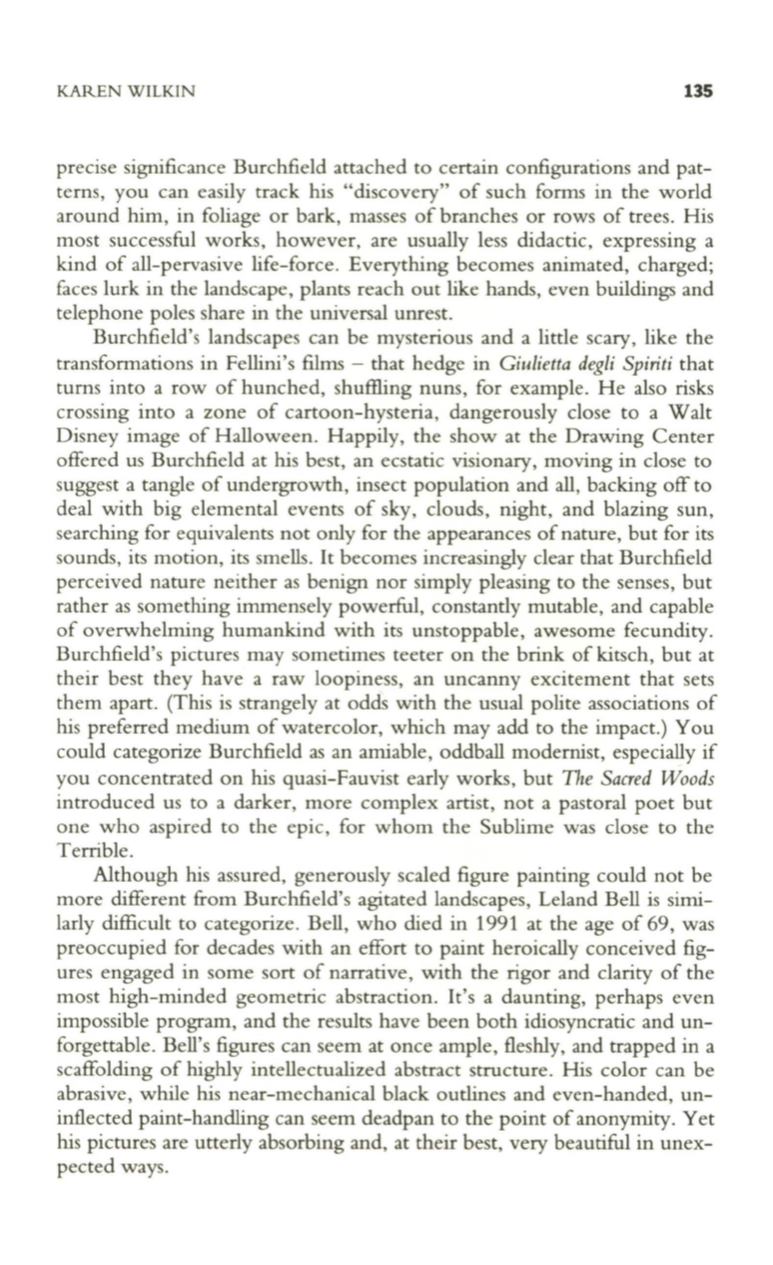
KAREN WILKIN
135
precise significance Burchfield attached to certain configurations and pat–
terns, you can easily track his "discovery" of such forms in the world
around him, in foliage or bark, masses of branches or rows of trees. His
most successful works, however, are usually less didactic, expressing a
kind of all-pervasive life-force. Everything becomes animated, charged;
faces lurk in the landscape, plants reach out like hands, even buildings and
telephone poles share in the universal unrest.
Burchfield's landscapes can be mysterious and a little scary, like the
transformations in Fellini's films - that hedge in
Giulietta degli Spiriti
that
turns into a row of hunched, shuffiing nuns, for example. He also risks
crossing into a zone of cartoon-hysteria, dangerously close to a Walt
Disney image of Halloween. Happily, the show at the Drawing Center
offered us Burchfield at his best, an ecstatic visionary, moving in close to
suggest a tangle of undergrowth, insect population and all, backing off to
deal with big elemental events of sky, clouds, night, and blazing sun,
searching for equivalents not only for the appearances of nature, but for its
sounds, its motion, its smells. It becomes increasingly clear that Burchfield
perceived nature neither as benign nor simply pleasing to the senses, but
rather as something immensely powerful, constantly mutable, and capable
of overwhelming humankind with its unstoppable, awesome fecundity.
Burchfield's pictures may sometimes teeter on the brink of kitsch, but at
their best they have a raw loopiness, an uncanny excitement that sets
them apart. (This is strangely at odds with the usual polite associations of
his preferred medium of watercolor, which may add to the impact.) You
could categorize Burchfield as an amiable, oddball modernist, especially if
you concentrated on his quasi-Fauvist early works, but
The Sacred Woods
introduced us to a darker, more complex artist, not a pastoral poet but
one who aspired to the epic, for whom the Sublime was close to the
Terrible.
Although his assured, generously scaled figure painting could not be
more different from Burchfield's agitated landscapes, Leland Bell is simi–
larly difficult to categorize. Bell, who died in 1991 at the age of 69, was
preoccupied for decades with an effort to paint heroically conceived fig–
ures engaged in some sort of narrative, with the rigor and clarity of the
most high-minded geometric abstraction. It's a daunting, perhaps even
impossible program, and the results have been both idiosyncratic and un–
forgettable. Bell's figures can seem at once ample, fleshly, and trapped in a
scaffolding of highly intellectualized abstract structure. His color can be
abrasive, while his near-mechanical black outlines and even-handed, un–
inflected paint-handling can seem deadpan to the point of anonymity. Yet
his pictures are utterly absorbing and, at their best, very beautiful in unex–
pected ways.


